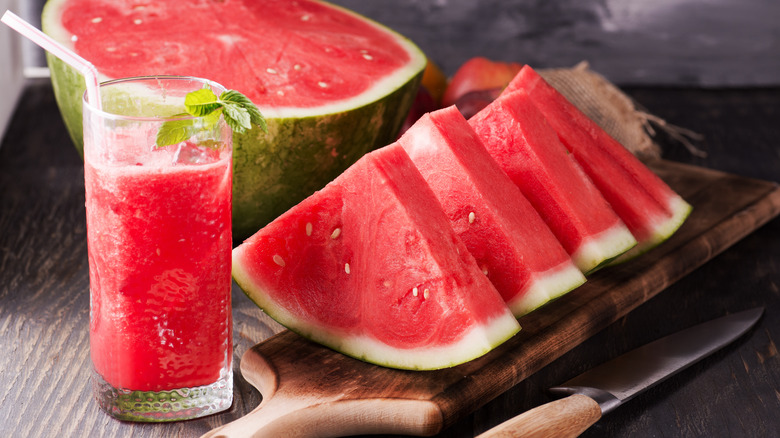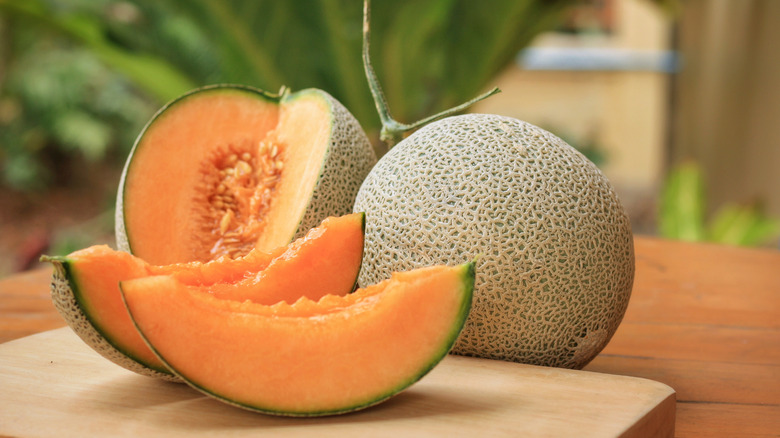Here's What Happens If You Dehydrate Watermelon
We may receive a commission on purchases made from links.
When you think of dried fruit, you probably think of a box of raisins, which are essentially dried grapes. While raisins are one of the most common dried fruits on the market, this doesn't mean they are the only types of dried or dehydrated fruit out there.
According to the Los Angeles Times, people have been eating dried fruit for centuries, going back to astronauts eating dried peaches on the moon to a sixteenth-century French custom of presenting your admirer with dried prunes. The main benefit of dried fruit, aside from the usual nutritional benefits one gets when eating fruit, is its long shelf life compared to undehydrated fruits. The National Center for Home Preservation tells us that, when stored properly, dried and dehydrated fruits can have a year-long shelf life. With everything from apples and peaches, to berries and even bananas (according to KitchenAid), you can easily stock up on an assortment of dried fruits that can be used in delightful recipes or just as a snack.
But can you dehydrate something like a watermelon? Healthline tells us that watermelon is 92% water, so what would happen if you were to remove all that moisture? Would you get a dried-out mess of brittle melon clumps or would you get something that's surprisingly good?
You can make watermelon jerky
Watermelon jerky? You've surely heard of beef jerky and turkey jerky, but watermelons, too? How exactly can you get jerky from a fruit that's known for being mostly solid water?
According to Southern Plate, watermelon jerky is described as being very similar to a Jolly Rancher. The texture is said to be slightly chewy like taffy with a fresh watermelon taste. To prepare watermelon jerky, Southern Plate walks us through the "recipe" (the process, we are told, is so easy to do it's not even much of a recipe at all), which involves removing the watermelon flesh from the rind. The flesh is then sliced into thin strips and laid out on dehydrator trays. The temperature of the dehydrator should be set at 135 degrees Fahrenheit and can take anywhere from 18 hours to a full day, depending on how much watermelon you use and the type of dehydrator you have.
The Purposeful Pantry explains that a good watermelon for dehydrating should be one that has sufficient weight and a bright exterior. A watermelon with a slight brown patch on the exterior will also work, as that is a sign that the watermelon wasn't picked too early. Watermelon can also be dehydrated in an oven, provided the oven is set anywhere between 140 and 170 degrees Fahrenheit. The oven process is also much shorter than the dehydrator, coming in at around four to six hours to dehydrate the melon strips.
Can you do this with other melons too?
If it's possible to turn a watermelon into a thin chewy strip of watermelon jerky, can this be done with other melons such as cantaloupe or honeydew? If so, what would these melons look like after a trip through the dehydrator?
According to PopSugar, dried cantaloupe is described as having a flavor similar to dried mango with a chewy texture. To prepare a dried cantaloupe, PopSugar explains that the cantaloupe's flesh must first be removed from its rind. Then, you must remove any and all seeds, before then placing the flesh in an oven set at 185 degrees Fahrenheit. The cantaloupe will bake for anywhere between two or three hours, the cubes or strips being flipped every 45 minutes. The recipe does warn that overcooking the cantaloupe can result in it drying out, losing its chewy texture for a crunchy one.
If watermelon, cantaloupe, or honeydew chew sounds tasty to you, you might enjoy learning that some forms of these delicious treats are also available for your favorite quadrupeds. In fact, your dog will likely love it as well. Kiki Kane of Rover tells us that dried melon chews and jerky are perfect treats for dogs. If you're someone who enjoys organic foods and wants your pet to avoid any store-bought or processed foods, melon jerky may be a good treat for you both.


